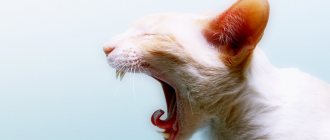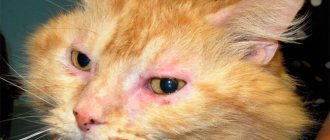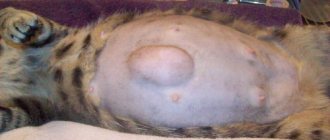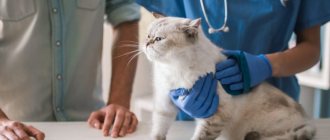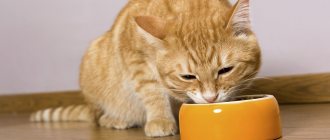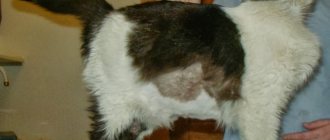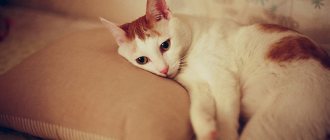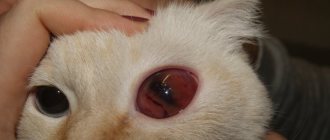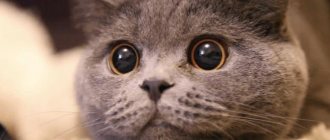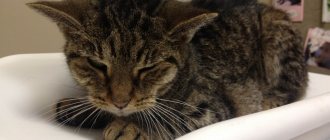Heart failure is the inability of the heart to pump the amount of blood the body needs. This disease occurs as a result of past infectious diseases. Heart failure is the most common cause of sudden death in pets. It affects not only dogs, but also cats.
Types of heart failure:
- Chronic heart failure. It develops slowly, sometimes imperceptibly, but at the same time, steadily.
- Acute heart failure develops quite rapidly, its time varying from several minutes to several hours.
As a result of the acute form, the cat instantly develops pulmonary edema, symptoms of which may include blood discharge from the mouth and nose, as well as shortness of breath.
Symptoms
Symptoms of heart disease in cats are not always visible, but she cannot complain about her health. Therefore, the health of the pet is entirely in the hands of the owner. He must monitor his pet and, upon discovering the first symptoms of the disease, should seek advice from a veterinarian.
A cat's panting with a protruding tongue is a sign of heart disease.
- Fatigue is difficult to notice in a cat, since it leads a generally quiet lifestyle.
- Dyspnea. Breathing occurs through the abdomen, without the participation of the chest.
- An attack accompanied by loss of consciousness. The cat, at this time, can be mistaken for a dead animal. Usually the attack passes quickly, but it happens that pets die, as their body experiences an acute lack of oxygen.
- The animal wheezes and meows terribly.
- Heavy breathing indicates pulmonary edema.
- Complete or partial paralysis of the hind legs.
- Cardiopalmus.
- Cyanosis of the gums.
- Loss of appetite.
In cats, coughing is not a cardiac symptom.
First aid for a cat who faints
The onset of an attack requires quick and correct actions by the owner, since, sometimes, it can end in death.
- Lay the cat down, and it is necessary to give her a side position of her head.
- Pull out your tongue.
- Place a cool compress on your head.
- Place cotton wool soaked in ammonia to your nose.
- The paws must be fixed higher than the head, so there will be more blood flow to the head.
- Call your veterinarian.
How to distinguish a healthy cat from a sick one
Since cats generally lead a calm lifestyle, they are couch potatoes, not all owners can distinguish a healthy animal from a sick one. She can report any changes in well-being by changing her behavior, that is, if the cat used to behave independently of the owner, but now does not leave him, then this indicates that something is bothering her.
Some people think that purring in cats is a sign of health. This is wrong. Purring, abruptly replaced by aggression or growling, indicates that she is in pain.
A healthy animal has:
- Smooth wool.
- The nose is wet and cold.
- The mucous membranes of the eyes are pinkish in color.
- The animal is vigorous and active.
Sick animal:
- Lethargic, lies more than usual.
- He tries to get away from everyone to a secluded place.
- Can be very excited.
- The meow is pitiful.
- Movements are clumsy.
- The nose is warm with cracks.
What is a heart attack
The term “heart attack” itself is not entirely correct, since it does not describe any specific disease, but only its consequence. Specifically in this case we are talking about the consequences of myocardial infarction, i.e. about the necrosis and death of part of the muscle tissue of the heart itself.
Since the heart is a muscular organ in itself, any disturbances in its structure disrupt the normal rhythm of work, have a bad effect on the heart rate and lead to other serious consequences.
Interestingly, it is not even the heart attack itself that is dangerous (although the animal may well die because of it). At this moment, the entire body may experience acute hypoxia (severe lack of oxygen), which in the foreseeable future leads to the development of kidney pathologies. In addition, in some cases even the cerebral cortex is affected, which also does not go away without a trace.
Causes of heart failure
- Congenital heart pathologies. In cats they are quite rare, occurring in approximately 2% of all cases.
- Diseases of the heart muscle caused by infectious diseases.
- Cardiomyopathy, which is caused by an inadequate diet in cats. They, as a rule, do not receive enough taurine, which is part of raw fish and meat. During cooking, it is destroyed.
- Heartworms and their larvae are found in mosquitoes. They are microscopic in size. When a mosquito bites, their larvae enter the animal’s bloodstream and settle in the pulmonary artery. Heartworms can grow up to 30 centimeters in size. With their presence in the circulatory system, they interfere with the outflow of blood and cause enormous damage to the arteries. Adults entangle the heart, thereby interfering with its full functioning. Heartworms can be detected using a blood test.
- Age-related hormonal changes. Heart failure is thought to occur in cats over 6 years of age.
- Metabolic disease. Sometimes it is caused by improperly structured nutrition.
Cats should be periodically screened for heartworms to help prevent heart disease. If a taurine deficiency is noticed in a timely manner, it must be introduced into the cat’s food, due to which the vital activity of the heart muscle is restored.
Diagnostics
Diagnosis must be carried out by a qualified veterinary cardiologist in order to prescribe the correct treatment. Typically it includes:
- Blood analysis.
- Analysis of urine.
- Ultrasound.
- Chest X-ray.
- ECG.
If a cat has been diagnosed with heart failure, then it should be excluded from planning for breeding, since the hereditary factor plays an important role.
What should you do if the above symptoms appear?
You should contact a specialist, and without delay. If the disease has not yet progressed far, in 85% of cases the animal will survive. A cardiologist will perform an examination for animals (the nature of diseases of the left and right atria is different and affects the appearance), along the way, he will do an echocardiogram and an X-ray of the cardiac area, draw blood for tests, and evaluate the fundus of the eye.
In some cases, a specific method is used - cardiac catheterization, when a flexible tube is inserted into the cardiac cavity to assess the anatomical and functional state of the septa and walls of the organ.
Sometimes physical examinations, auscultation (an informative and diagnostic method of heart pathologies) and standard percussion are required. They make it possible to detect an increase in the boundaries of an organ and identify noises without the use of expensive procedures. Once the diagnosis is confirmed, therapy is prescribed, which may depend on the degree of the disease, cardiac changes, and blood flow.
The owner will have to independently record changes in the condition of his cat, and here it will be enough to count the number of breaths that the animal takes at rest.
If the cat is sleeping, you need to note the time (a minute) and monitor the number of breaths (raising the sides). Breathing movements should be counted several times a day. Then write them down and transmit the results to the veterinarian, who will be able to monitor the patient’s health over time. Heart disease in cats is initially characterized by nonspecific signs that interfere with diagnostic measures.
The reasons leading to damage to the heart muscle by various developmental mechanisms are:
- Arrhythmia;
- Heartworm infection;
- Action of infectious agents;
- Valve pathologies – atresia, aplasia or stenosis;
- Incomplete relaxation or insufficient compression of the myocardium;
- Vascular pathologies, due to which resistance to blood flow increases;
- Shunts between the heart chambers.
Heart failure is prone to development if one or more of the above factors are present. When there is insufficient blood flow, the phenomenon of congestive heart failure occurs.
Treatment and care
Treatment of cats for this disease depends on the severity of the disease. Sometimes it is carried out exclusively during a daily stay in a veterinary clinic. Cats do not undergo heart surgery. During illness, they are prescribed only drug treatment. The earlier they are diagnosed with heart failure, the better their chances of survival. For recovery you need:
- Complete rest of the animal. The pet must be limited from any stress - this could be a working vacuum cleaner, traveling on public transport or the arrival of guests.
- Treatment with diuretics removes excess fluid from the body. During illness, fluid can accumulate near the lungs, thereby causing swelling. In the chest, causing pleurisy. In the abdominal cavity, causing ascites. Reducing the amount of fluid in the body helps reduce the load on the heart.
- Treatment with ACE inhibitors, which reduce the load on the heart by increasing blood flow.
- Positive inotropes make the heart pump more blood, control the heartbeat, and slow it down so it pumps more blood into the body.
- When the fluid content in a cat’s body is greatly increased, the veterinarian will pump it out and thereby remove it from the body. The cat will feel relief for a while, but this will not last long, as the fluid will return. Pumping is carried out by inserting a sterile needle into the required place.
- Balanced diet.
Heart failure in an animal requires careful care:
- Cats need low-salt food. Salt retains water in the body, which leads to poor circulation.
- Feed with a high content of taurine and protein.
- Heart failure requires regular veterinary consultations and ongoing treatment.
Diagnostics
There are several effective diagnostic techniques that allow you to accurately determine whether a cat has heart disease (as well as identify its type):
- Electrocardiogram (ECG ). This is a graphical recording of the electrical currents flowing within the myocardial muscle tissue. The technique can be very useful for detecting irregular heart rhythms, but experienced specialists can tell a lot about the condition of the heart as a whole using just the graph recording.
- Radiography . Useful in recording abnormalities in the volume and size of the heart, as well as in identifying the presence of effusion in the chest and abdominal cavities. In addition, X-rays are often used to check the effectiveness of prescribed treatment (disease dynamics). To increase the efficiency of the study, radiography is done with contrast. In this case, a special substance is injected into the blood of a sick animal, which glows brightly when exposed to X-ray radiation.
- Echocardiography (a type of ultrasound). An extremely necessary and extremely useful technique. Allows you to visually assess the size and volume of the heart muscle, the thickness and consistency of the walls of the ventricles and atria. An experienced veterinarian, using echocardiography, will be able to accurately determine the source of even mild murmurs in the animal’s heart. This is the only test that helps identify different types of heart disease in cats. Please note that to increase the effectiveness of the study, before conducting it, it is imperative to cut and shave the area of skin over which the doctor will move the sensor. Another advantage of the procedure is that it is completely painless and there is no need for rigid fixation of the body. If the cat is calm, it may be enough just to hold him and talk to him soothingly.
- Complete blood and urine tests . They do not often indicate heart disease directly, but they greatly help determine its exact cause. In particular, to identify the presence of specific antibodies or pathogens in biological fluids.
Prevention
Cats suffering from heart failure need preventative care to keep them active. We need to try to “stir up” animals that lead a “sofa” lifestyle. Obese cats are at risk for heart disease. You need to ensure your pet is eating properly. An annual checkup with a veterinarian will protect him from heart disease.
Sphynx, British, Persian, Scottish cats, and Maine Coons are also susceptible to heart disease. This does not mean that all cats of these breeds, sooner or later, have heart problems. This statement means that representatives of these breeds develop heart disease at an earlier age.
Heart failure in neutered cats is quite common because these animals are very lazy. They lead a sedentary lifestyle and are obese.
It is necessary to pay increased attention to neutered cats, as they are more susceptible to heart disease.
A diagnosis of heart failure in cats is not a death sentence. The main thing is to notice the first symptoms of the disease in time, carry out regular examination and treatment. Monitor your pet's diet. With proper care and care, a cat can delight its owner with affection and beauty for a long time.
Treatment regimen for a cat after a heart attack
Any treatment regimen for a cat after a heart attack involves creating the most comfortable and calm conditions for the pet. In particular, for the first two weeks from the moment of the attack, you should not play with the cat, you cannot let it go outside, you cannot move, have a party at home, or do repairs. Lack of stress is a sure guarantee of an animal’s recovery! In addition, the following conditions must be met:
- The animal is given unlimited access to clean drinking water, which it must have at all times, regardless of the time of day.
- It is very advisable to prepare a high-quality, balanced diet for your pet, or immediately use special veterinary holistic treatments for animals with heart pathologies.
- Diuretics are prescribed to prevent edema (and in case of heart pathologies they will almost certainly occur).
- ACE inhibitors are required. They normalize the condition of the vascular system.
- Cardiotonics that improve heart contractility are urgently needed.
During the first three months, your pet should be taken to the veterinarian at least twice a month. The specialist needs to assess the dynamics of recovery and, if necessary, adjust the prescribed treatment. And even after this, a cat that has suffered an attack is shown to the veterinarian at least once a quarter.
Heart medications for cats
The following heart medications for cats can be used in veterinary practice:
- Diuretics include cheap and effective furosemide and diacarb.
- Enalapril, Ramipril, Benazepril are used as ACE inhibitors in veterinary medicine.
- Adrenaline can be used to stimulate cardiac activity in the first hours after an attack; subsequently, caffeine-sodium benzoate is used (it is much safer and “softer”).
- Pimobendan is prescribed as a cardiotonic.
Drugs affecting heart function
A significant group of cardiac drugs directly affects the heart muscle, normalizing metabolism within tissues, regulating the strength and frequency of contractions. Veterinarians are forced to borrow some drugs from humane (human) medicine, while others have been successfully adapted for animals and are sold in veterinary pharmacies.
Beta blockers
These include a group of drugs that block special receptors affected by the well-known hormone adrenaline. By binding to these receptors in the heart, beta blockers prevent adrenaline from overstimulating the organ.
The most common drugs in the group are bisoprolol and atenolol, they are primarily indicated for cats suffering from HCM (you can read more about this disease and other cardiomyopathies in our article “Cardiomyopathy in cats, symptoms and treatment of the disease”).
ACEI
The full name of this group is angiotensin-converting enzyme inhibitors. Sometimes they are used for hypertrophic, but are most effective for dilated cardiomyopathy.
By acting on specific chemical compounds in the body, these drugs reduce high blood pressure, protect the heart from harmful effects, dilate the blood vessels through which blood moves to and from the heart, thus improving the force of contraction of the heart muscle.
These include captopril, enalapril, ramipril (available in the form of the widely used veterinary drug Vazotop R), benazepril (veterinary Fortecor).
Antiarrhythmic drugs
Antiarrhythmic drugs are used to normalize the heart rhythm. Most often, cardiac glycosides (digoxin) are used for animals, and less often - sotalol and amiodarone.
Causes of heart attack in cats
The causes of heart attack in cats are traditionally recorded as follows:
| Age-related changes | Changes are most often associated with hormonal changes. And in general, with age, it becomes more and more difficult for the heart to work. And physical activity leads to even greater wear and tear of the heart in old age. Of course, normal amounts of exercise are beneficial; they strengthen all muscles. But moderation is important in everything. The well-being of the animal must also be taken into account. Still, feel sorry for the aging mustache. |
| Poor nutrition | Leads to the deposition of cholesterol on the walls of blood vessels. For this reason, blood supply is hampered, and oxygen starvation occurs. And without oxygen, cells die. Hence the risk of a cat developing a heart attack. |
| Broken thrombus | Leads to blockage of blood vessels. This, in turn, disrupts tissue nutrition. Due to lack of oxygen they die. Hence myocardial infarction in cats. |
| Other reasons | Problems with blood vessels: inflammatory processes (including those caused by bacterial infections), congenital anomalies can also cause heart attacks in cats. |
